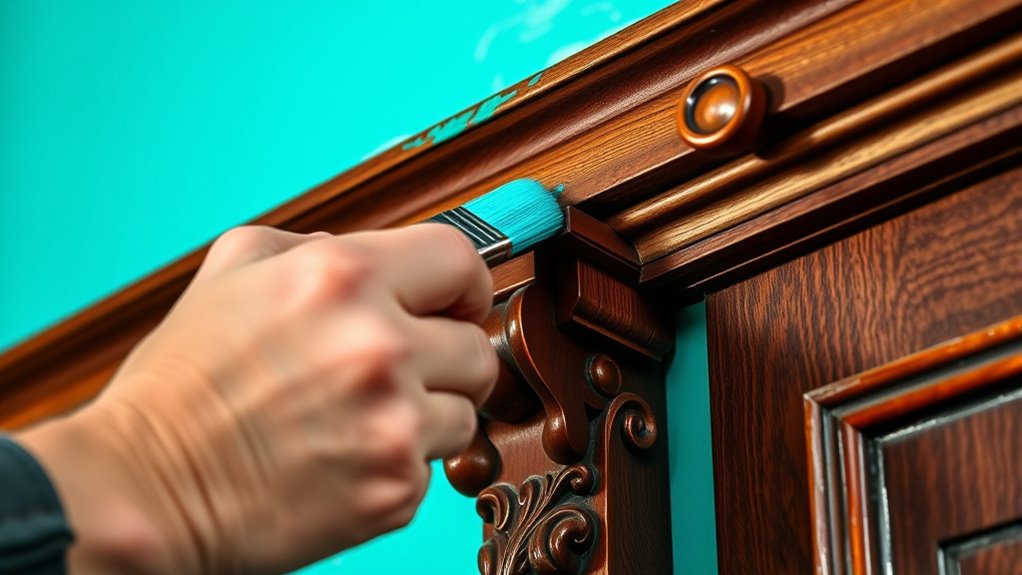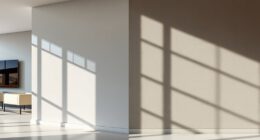To paint woodwork in a contrasting color effectively, start by choosing shades that complement your walls and decor, considering both tone and finish. Use painter’s tape for crisp edges and apply several thin coats for smooth coverage, allowing proper drying between layers. Opt for finishes like semi-gloss for durability and easier cleaning. Careful surface prep and precise masking will guarantee sharp lines and a polished look. Keep in mind, mastering these techniques can truly enhance your space’s style and impact.
Key Takeaways
- Choose a contrasting color that complements wall and decor for a bold, cohesive look.
- Use painter’s tape for clean, sharp lines and mask surrounding surfaces precisely.
- Apply multiple thin coats, allowing proper drying time to ensure even coverage and vibrant contrast.
- Select a suitable finish (semi-gloss or matte) based on desired sheen and durability needs.
- Prepare surfaces thoroughly with sanding and priming for smooth application and long-lasting results.

Painting woodwork in a contrasting color is a bold way to add personality and visual interest to your space. When you decide to go with a contrasting hue, it’s essential to contemplate color coordination carefully. You want the new shade to complement the wall color and overall room decor, rather than clash or overwhelm. Think about the mood you’re aiming for—if your walls are a soft neutral, a darker or more vibrant woodwork color can create a striking focal point. Conversely, if your walls are bold, a more subdued woodwork color might be the best choice to maintain balance. When selecting your contrasting color, take samples and view them in different lighting conditions to see how they evolve throughout the day. This ensures that your chosen palette harmonizes well and avoids any surprises once the project is complete.
Contrasting woodwork adds personality; choose colors that complement walls and lighting for a balanced, striking look.
Next, pay attention to the paint finish. The finish you choose impacts not only the look but also the durability of your woodwork. For trim, moldings, and doors, a semi-gloss or high-gloss finish is typically recommended because it reflects light, highlights the contrasting color, and is easier to clean. Matte or satin finishes, on the other hand, tend to absorb light, which can soften the appearance but might not stand up as well to frequent cleaning in high-traffic areas. When applying contrasting colors, a smooth, even paint finish enhances the visual impact and gives your woodwork a polished, professional appearance. Proper surface preparation, like sanding and priming, ensures that the paint adheres well and reduces the chances of uneven or streaky results.
To achieve the best contrast and a clean look, use painter’s tape to mask off surrounding surfaces precisely. Apply multiple thin coats rather than one thick coat; this helps avoid drips and ensures a more uniform finish. Allow adequate drying time between coats, especially if you’re working with darker shades that may require extra coverage. When the final coat is dry, carefully remove the tape to reveal crisp, sharp lines. For an even more refined look, consider lightly sanding between coats and applying a clear protective topcoat if the woodwork will face frequent contact or moisture. Additionally, choosing a self-watering plant pot with a contrasting color can serve as an inspiring decorative element that complements your painted woodwork, adding both function and style to your space.
Ultimately, painting woodwork in a contrasting color is about balancing boldness with harmony. With a thoughtful approach to color coordination and choosing the right paint finish, you’ll create a striking effect that elevates your space and showcases your personal style.
Frequently Asked Questions
How Do I Choose the Best Contrasting Color for My Woodwork?
To choose the best contrasting color for your woodwork, consider your existing color scheme and aim for aesthetic balance. Pick a hue that complements your walls or furniture, creating visual interest without clashing. Use color coordination principles like the color wheel to find a striking yet harmonious contrast. Test small patches first, ensuring the contrast enhances your space and reflects your style before committing to the final paint.
What Tools Are Essential for Painting Woodwork in Contrasting Colors?
You’ll need a good brush selection—preferably angled or fine detail brushes—to achieve crisp lines. Don’t forget painter’s tape for clean edges and to prevent color bleed. A high-quality primer helps the contrasting color pop, and a small roller can cover larger areas efficiently. These essential tools make your project smoother, ensuring your contrasting woodwork looks sharp and professional, even if you’d rather be doing anything else.
How Can I Prevent Paint From Bleeding Onto Surrounding Surfaces?
To prevent paint from bleeding onto surrounding surfaces, start with proper surface preparation by cleaning and sanding edges. Use edge masking tape carefully along the boundaries to create a clean line. guarantee the tape adheres firmly and press down to prevent leaks. Applying a thin, even coat of primer before painting helps seal edges. Taking these steps minimizes bleed-through and results in sharp, professional-looking contrasting woodwork.
What Are the Best Techniques for Achieving Clean, Sharp Lines?
To achieve clean, sharp lines, start by applying painter’s tape precisely along the edges you want to protect. Use edge masking techniques to press the tape firmly, preventing paint bleed. When painting, use a high-quality brush or small roller for controlled application. Carefully remove the tape before the paint dries to reveal crisp lines. This combination of edge masking and painter’s tape guarantees a professional, sharp finish every time.
How Long Should I Wait Between Coats for Optimal Results?
Think of your project as a delicate dance; patience is key. Wait at least 2-4 hours between coats, allowing the paint to dry thoroughly. This drying time guarantees proper paint adhesion, preventing smudges or peeling later. Rushing through coats can lead to a sticky, uneven finish, so give each layer ample time to settle and cure. Your woodwork will thank you with a crisp, flawless contrast.
Conclusion
Painting woodwork in a contrasting color can truly elevate your space, creating visual interest and highlighting architectural details. While some argue it risks overwhelming a room, evidence suggests that when done thoughtfully, it enhances depth without clutter. By carefully choosing shades and applying precise techniques, you can achieve a sophisticated look that feels both modern and timeless. Ultimately, contrasting woodwork isn’t just a design trend; it’s a proven way to add personality and style to your home.








